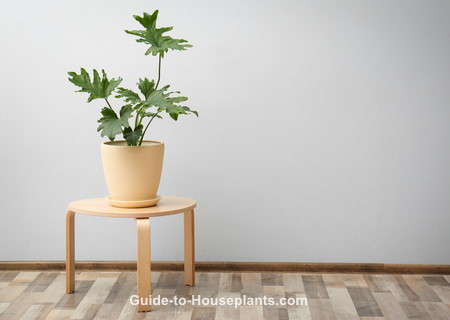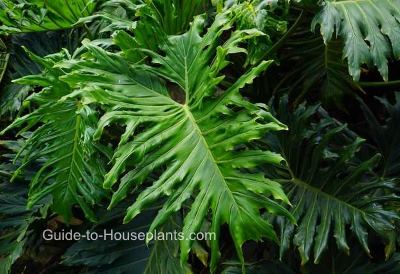Split-Leaf Philodendron
Botanical Name: Philodendron bipinnatifidum
Split-leaf philodendron is another dependable house plant from the Araceae family. It also happens to be one of the most captivating.
 Image © Chernetskaya | Dreamstime.com
Image © Chernetskaya | Dreamstime.comFew houseplants make a huge impact like this one. This jungle giant is surprisingly easy to please indoors. Although it prefers high humidity, split-leaf philodendron is fairly tolerant of most homes. Use a room humidifier, if you need to boost the moisture in the air.
This stunning philodendron plant is a tree-like shrub. Young plants have sturdy, upright stems, which tend to lie horizontally as the plant ages. They eventually sprawl to become twice as wide as they are tall, so give your house plant plenty of room to spread out. You may want to stake up your plant to provide support.
The foliage is stunning. When young, the glossy, heart-shaped leaves are deeply indented, and become more deeply cut as they grow. Some varieties of split-leaf philodendron have wavy margins. Big leaves are dust-catchers. To clean them, gently wipe the leaves with a damp cloth.
Year-Round Care
Wondering whether to repot? Pot up in spring or early summer when the roots fill the pot, usually every couple years. Use a container with drainage holes to prevent root rot. Once the plant gets big (top-heavy), it's a good idea to use a heavy container to prevent it from toppling.
What do you do with aerial roots? Long aerial roots may appear near the base of the plant. You can cut off a few with pruners without hurting this plant. Better yet, tuck them back into the pot or coil them on top of the soil.
Something bugging your plant? New plant growth may attract aphids, which can cause yellow specks and crinkled leaves. Treat any infestation immediately.
Varieties and Buying Tips
This plant is also known as P. selloum and may be sold under that name.
A few named varieties make good house plants. 'Xanadu' philodendron is a newer cultivar with smaller leaves than the species and only grows to 3 ft (90 cm) wide. 'Hope' is a vigorous, full-sized hybrid. 'German Selloum' has finely cut leaves with wavy lobes.
Looking for this look-alike? There is a similar-looking plant that goes by the same common name. Swiss Cheese Plant isn't a philodendron at all -- it is Monstera deliciosa.
Split-Leaf Philodendron Care Tips

Origin: Brazil
Height: To 6 ft (1.8 m) indoors, depending on variety
Light: Moderate to bright light. No direct sun, which can cause brown scorch marks on the leaves.
Water: Keep soil moist spring through fall. Allow surface to dry out between waterings in winter. Yellow leaves are caused by overwatering.
Humidity: This rainforest native prefers relative humidity above 40%. Mist foliage occasionally. If your home is really dry, use a cool-mist room humidifier to boost moisture in the air around it. Brown leaf tips may be caused by dry air.
Temperature: Average to warm 65-80°F/18-27°C year-round. Split-leaf philodendron will tolerate a low of 60°F/16°C in winter.
Soil: Peat moss-based potting mix.
Fertilizer: Feed monthly spring through fall with a balanced (such as 10-10-10 npk) water-soluble fertilizer diluted by half. Lack of nutrients may cause little or no growth and small leaves.
Propagation: Division. Cut through the thick roots with a serrated knife and pot up the plants separately.


